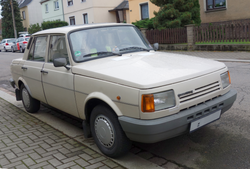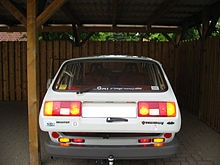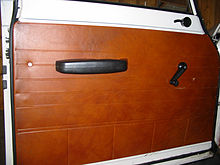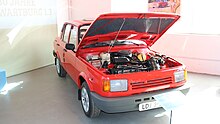Wartburg 1.3
| Wartburg | |
|---|---|
| Wartburg 1.3 | |
| Sales designation: | Wartburg 1.3 |
| Production period: | 1988-1991 |
| Class : | Lower middle class |
| Body versions : | Limousine , station wagon |
| Engines: |
Petrol engines : 1.3 liters (43–47 kW) |
| Length: | 4216-4276 mm |
| Width: | 1644 mm |
| Height: | 1495-1695 mm |
| Wheelbase : | 2450 mm |
| Empty weight : | 900-960 kg |
| Previous model | War castle 353 |
The Wartburg 1.3 was a passenger car of VEB Automobilwerk Eisenach , which was manufactured from 1988 to 1991. The 1.3 is the successor to the Wartburg 353 .
Wartburg 1.3 (1988-1991)
Prehistory of 1.3 (economic background in the GDR)
At the beginning of the 1960s, AWE began developing a four-stroke engine , but this was not welcomed by either the Central Committee or the Politburo . The engine was actually ready in 1972, but it could not be used because of the socialist planned economy within the Comecon . The Wartburg engine AWE 1600 (working name: 400) was a four-cylinder, four- stroke in-line engine with a displacement of 1.6 liters and 82 hp. It could have been built into car 353 with relatively minor adjustments.
In 1974 Great Britain banned the import of what was known there as the Wartburg Knight (translated into German: Wartburg-Ritter ) because of the two-stroke engine that was no longer considered to be contemporary . What remained were the western export countries on the Iberian Peninsula, Spain and Portugal , in Scandinavia, mainly Denmark , as well as Belgium and Greece. Two-stroke Wartburgs were no longer allowed to be sold in these countries from 1979 due to ECE standards. 1500 such vehicles were then still unsold on the dump, and the acquisition of freely convertible foreign currency , which is important for the economy of the GDR , stalled. But the AWE no longer had an engine that had been developed on a modern level.
As a result of this development, the Wartburg factory had been ordered to produce 7500 four-stroke Wartburgs for export as early as 1978 as a planned state task. However, since the installation of a new engine was much more complex, tedious and expensive than expected, this requirement was later withdrawn. In addition to the further development of the required unit, this would also have required the construction of a new plant, a total of 4 to 5 billion marks, due to the outdated technical status of the production facilities. In order to finance the necessary investments, Erich Honecker ordered that the purchase price for a new car had to be paid when the vehicle was ordered from IFA sales . After Günter Kleiber intervened personally at Honecker, together with the information that this order violated all laws of the GDR, the latter withdrew this instruction.
The Politburo of the SED decided on November 6, 1979, with the exception of further developments on the Trabant, to stop all research and development work in the field of car construction in the GDR. Thus, although the export of two-stroke cars to NSW was impossible, the production of a Wartburg with a GDR four-stroke engine was rejected.
Due to the enormous sales difficulties with the two-stroke Wartburg, the AWE was later approved by political authorities again to develop a four-stroke engine. The factory then worked on a unit with three cylinders, which would have been operational in 1986.
The Central Committee Secretary of the SED for economic issues, Günter Mittag , signed a contract with Volkswagen AG at the Hanover Fair in 1984 without authorization and not covered by GDR law (such a conclusion would have been within the competence of the GDR government) . The Volkswagen engine that the AWE and the Barkas factory in Karl-Marx-Stadt (today Chemnitz ) were assigned was too big for the engine compartment of the Wartburg 353 and also required a different transmission. A longitudinal installation was attempted in the 1.3 prototype, but was discarded for reasons of aesthetics and a specification of the barcas works (transverse installation). This transverse installation required an elaborate redesign of the front end and the drive and thus a considerably larger investment than would have been necessary for the engine that was developed in-house. Despite the protests of the chief designer at the AWE works manager, the transverse installation of the VW engine was pushed through (quote works manager: " And if your engine is made of gold, the VW engine comes in! "). The additional effort was part of the cause of the cost explosion from 1984 in connection with the VW engine. As a result of the deal with Volkswagen, development of the AWE three-cylinder four-stroke engine came to a standstill.
Technical development prototype with longitudinal installation
When in 1987 the order was received to adapt the Wartburg 353 W so that the VW engine could be accommodated in it, this did not spark any enthusiasm in Eisenach. Under strict secrecy, a Wartburg 353 W was brought to the VW factory in Wolfsburg , where it was equipped with a VW engine. The 353 W was then adapted in Eisenach. This car, called the "coati" due to its longer engine compartment, was based on a 353 W Tourist and had a longitudinally installed motor with the gearbox of the 353 W. The prototype, which is still working today, is in the museum in Eisenach .
Technical development and changes in series production
Series production of the Wartburg 1.3 limousine with a VW engine began in Eisenach on October 12, 1988 . This 43 kW (58 PS) engine was originally developed for the VW Polo 86c and manufactured in the GDR for VW and for its own use. In addition to the new engine and a new four-speed gearbox, there was a slightly different interior compared to the Wartburg 353 . The main body and the vehicle concept with a separate box profile frame and attached trapezoidal body were retained. Like the Trabant 1.1 , the Wartburg 1.3 looks very similar to its predecessor.
First of all, the new Eisenach car was to be called "1300" and the S version was to have a dashboard like the one in the Polo 2 (built 1981-1994) and a five-speed gearbox. The 1.3 Tourist was shown together with the limousine at the Leipzig autumn fair in 1988 , but series production of the 1.3 Tourist N / S only started in February 1989. So there was a period of around four months during which the 353 W Tourist / 353 W Trans were still being manufactured in parallel with the 1.3 sedan.
Changes compared to the Wartburg 353 W.
- Interior: initially with parts from the 353-W production (brown fabric, short black handles), but then with new ones (black fabric, long black handles from the Opel shelf). It was the same with the seats. The headrests were initially taken from the 353 W, but then replaced by foam-covered foam in the course of the series.
- Dashboard and controls: Except for the new KMVA (instantaneous fuel consumption display), the instruments have been taken from the 353 W, the dashboard and its design have been completely redesigned. A new steering column combination switch (indicator / wiper) was also used. The heating with ventilation fan has also been completely redesigned.
- Body: new plastic-coated bumpers, completely new front end - including a modified bonnet, different turn signal arrangement (turn signals integrated into the front section, small additional turn signals on the fenders) - new exhibited fenders front and rear due to increased lane widths and a modified rear: In addition to the trunk closure with new flat four-chamber lights, a slightly higher trunk lid (sedan) was also introduced. Because the tail lights are no longer visible when the tailgate is open, the station wagon has small additional lights behind the tailgate under the loading sill, as is the case with the 353, see picture. The front headlights, the doors and the exterior and interior door handles, as well as the front and rear windows, which were installed from 1984 onwards, were adopted from the 353 W. At the Tourist, the rear fenders and tailgate were again made of fiberglass-reinforced plastic. The concept of exchanging entire vehicle lots quickly and cheaply has been expanded with the 1.3.
- Technology: Front and rear track widening and new front wheel drivers, modified frame, new 1.3-liter engine (similar to the EA-111 series from VW). This engine generation was used as the BM860 in the Wartburg, as the BM880 in the Barkas B 1000-1 and from 1990 as the BM820 with a smaller displacement (1.1 l) in the Trabant 1.1 . The engine itself was manufactured in Karl-Marx-Stadt for VW in a modified form. The new four-speed gearbox from AWZ was installed across the direction of travel, which is why new drive shafts of different lengths had to be introduced.
- The transmission caused problems from the start. It had been developed for the Trabant 1.1 and did not harmonize either in the translation, in the gradation, or in the dimensioning of the components with the more powerful engine and the higher weight of the Wartburg. A five-speed gearbox should bring improvements.
- Experiments: Innovations were repeatedly tested in the current series. These included a floating caliper brake and a five-speed transmission.
Changes during production
Changes in 1989
- Detail change on the door cover: Instead of the brown fabric previously used, brown synthetic leather has now been used.
Changes in 1990
- Door cover: black fabric instead of synthetic leather
- new long hard foam handles at the front instead of the previously short old 353-W handles
- first towing eye at the rear of the tourist
- Replacement of the stone chipping film with a suitable plastic part with a longer service life
- new door handles with black covers
Changes in 1991
- Complete change of the pedals: new suspension
- new dimming interior mirror
- Towing eye at the rear now also on the sedan
- Front seats taken from the Opel Kadett E and adapted using an adapter
- Door cover: new Opel handles, also from the E-Kadett
- shorter throttle cable
- new closer fitting exterior mirror (see Trabant 1.1)
Production was stopped on April 10, 1991. The last Wartburg rolled off the assembly line that day.
The investment of around 9 billion GDR marks (with gearbox) was not worth it; a complete in-house development would only have cost around 4 to 5 billion marks (including the renewal of the factory in Eisenach). The VW engine was just a specification from Berlin, not from Eisenach. Tried and tested and from a well-known brand, it had the advantage of greatly improving the value of the vehicle.
Wartburg 1.3 model range
- Limousine, four-door
- Station wagon, four-door ("Tourist")
- Pickup, two-door ("Trans")
- Prototypes:
- Volkspolizei prototype (1990) (number of items: 3)
- Irmscher -Wartburg "Wartburg New-Line" (1990) (number of items: 2)
- Wartburg Tourist Concept L (1990) (Quantity: 1)
- Ihling pickup (longer than "Trans") (number of items: 6)
- Trailer (Wartburg Rallye Team) (number of items: 2; 1st rally look in the Museum Eisenach, 2nd white as "normal" trailer (active use))
- Wartburg Rallye 1.3 (1st rally look on rally trailer in the Eisenach Museum; quantity: at least two - fifty were built for FIA approval and 48 of them were sold. Today, however, there are many replicas on the road that do not have any extra rally equipment (internally ventilated disc brakes and - because of the ground clearance - 353 W rear silencer). Small curiosity: There were also rally service tourists, but the exact details are not known.)
Technical data: Wartburg 1.3
- L / W / H: 4,220 / 1,645 / 1,495 mm (sedan); 4,280 / 1,645 / 1,520 mm (tourist); 4,224 / 1,644 / 1,695 mm (Trans); Axle base 2450 mm
- Ground clearance (loaded): 122 mm
- Engine: four-cylinder four-stroke gasoline engine , liquid-cooled, similar to the VW EA 111 series (Polo, partly Golf; engine codes: N; NZ), “Alpha Deal” in the mid-1980s
- Engine mass: 107.5 kg
- Displacement: 1,272 cm³
- Output: 43 kW / 58 PS at 5400 rpm (until June 1990), 47 kW / 64 PS (from July 1990)
- Torque: 96 Nm (9.8 kpm) at 3300 rpm
- Fuel: petrol , min 91 RON
- Carburetor: a downdraft carburetor 34 TLA (type: Weber)
- Gearbox: synchronized four-speed change gearbox with remote control (weight with oil approx. 29 kg)
- Clutch: single-disc dry clutch TF 180-120 (TF 180 DE2R)
- Chassis: independent wheel suspension , driven at the front, asymmetrical hump rims 4 1 / 2J × 13H 1-BJ 45-1 (13 ″), tires 165/80 R 13 82 S sl, 175/70 R 13 80 S
- Turning circle: 10.8 m
- Brakes: drum brakes, lockable at the rear, disc brakes at the front
- Accumulator: 12 V / 44 Ah
- Ignition system: transistor ignition with transmitter principle, Hall effect
- Electrical system: three-phase alternator 14 V / 57 A
- Main lighting: H4 halogen headlights 60/55 watts
- Trunk: 525 l (sedan); Loading area L / W: 1,940 mm / 1,300 mm (Tourist); 1,700 mm / 1,400 mm (Trans)
- Total empty weight / payload / total load: Sedan: 900 kg / 420 kg / 1,320 kg; Tourist: 960 kg / 450 kg / 1410 kg; Trans: 840 kg / 550 kg (of which 440 kg; on the loading area) /1,320 kg;
- Consumption per 100 km (factory specification): 6.8 l (at a constant 90 km / h); approx. 7.4 l (Euro-Mix)
- Top speed: 150 km / h. according to vehicle registration documents: 135–141 km / h
- Tensile load: unbraked 500 kg; braked 650 kg (with retrofitted trailer coupling )
- Roof load: without sliding roof 60 kg, with sliding roof 40 kg (exception see: Wartburg Concept L )
- Fuel tank capacity: 43 l
- Ramp ability: front 24%; rear 15%
- CO 2 emissions: 170 g / km
- Manufacturer key number: 0873
- Key number model: 302 (Limo); 305 (tourist)
- Environmental badge : 1 (also with U-KAT) but there are exceptions, e.g. B. with retrofitting to G-KAT for badge 4
Production period and numbers (1988–1991)
- Wartburg 1.3 sedan 10/88 - 04/1991
- Wartburg 1.3 Tourist 02/89 - 04/1991
- Wartburg 1.3: 152,775 vehicles
- of which Wartburg 1.3 "Trans": approx. 920 vehicles
Prices for the Wartburg 1.3 and underlying calculation
- Wartburg 1.3 sedan: 30,200 marks
- Wartburg 1.3 S sedan: 31,580 marks
- Wartburg 1.3 Tourist: 33,775 marks
- Wartburg 1.3 S-Tourist: 35,190 marks
Price calculation Wartburg 1.3, normal limousine:
- Charges for the correct evaluation of human labor, which is paid directly to the state budget: 744 marks
- Production fund levy for the use of the basic resources, which is paid directly to the state budget: 2,906 marks
- Profit for the company: 940 marks
- Operating price: 25,850 marks
- Industry price: 28,700 marks
- Transport and trading costs as well as necessary profit for VEB IFA sales: 1,500 marks
- Makes the above 30,200 marks
The model change from the 353 to the 1.3 was associated with a significant price increase of at least 60%. The base price of the Wartburg 353 was around 18,000 marks , the real sales price between 20,000 and 21,000 marks. The base price of the Wartburg 1.3 was increased to over 33,000 marks. For many GDR citizens who had been saving up for a new Wartburg for years and who had calculated the price as - as is generally the case with consumer goods in the GDR - at least somewhat reliable (price increases tended to be insidious), suddenly an unforeseen financing problem arose. Hire purchase or borrowing were not provided for when buying a new car (although otherwise quite common) and leasing was unknown in the GDR; the vehicle was always to be paid for in cash or by check at the time of collection. Postponing the purchase was theoretically possible, but problematic; if a vehicle was not purchased, the authorization - unpredictable for the individual - was postponed by months or years.
This jump in price for the long-awaited four-stroke Wartburg caused disillusionment among the population with the future products of the GDR automobile industry. Their price was now roughly the same as the Citroën GSA , which was imported from France until 1986 , whose design was four years younger than that of the Wartburg and which was more extensively equipped than the latter.
One reason for the enormous jump in prices was the very high costs that had to be expended for the introduction of the new drive. Despite the public outrage about the prices, there was never a sales problem for the vehicle before the fall of the Wall. Thanks to the four-stroke engine, the vehicles could now be sold relatively successfully in countries such as Hungary, Poland and CSR. Even these Eastern Bloc countries had previously throttled or stopped importing the Wartburg 353 due to the environmental pollution of the two-stroke engine.
Prototypes and test samples
Countless prototypes that can be found in museums today (for example Automobilwelt Eisenach , Saxon Vehicle Museum Klaffenbach in Chemnitz) prove that other vehicles were possible and in preparation. Partly for political reasons, partly for material reasons (the resources for a complete changeover of production were not available in the East German economy), these prototypes never went into series production. Last but not least, the COMECON car projected with Škoda , among others, cost important development years.
The prototypes Wartburg 360 (1974) and 610 M (1978) with a self-supporting body were never built in series, although the Wartburg 360 has similarities with the Audi 80 and the Audi 100 .
Wartburg 1.3 "New-Line" (1990)
In the middle of 1990 the AWE presented the modernized Wartburg 1.3 “New-Line”. This vehicle was created in cooperation with the Opel tuner Irmscher ( Irmscher-Wartburg ) and was the last attempt to keep the Wartburg on the market. There were innovations in the body and the technology:
The supplementary equipment of the body included new bumpers (in the style of the Opel Kadett E), side skirts and a rear apron. Also new were the modified exterior mirrors from Engelmann with a teardrop design; Irmscher aluminum rims (bolt circle 4/160 in 6 × 14 "with 185/60 tires) were also part of the new appearance.
The interior has been upgraded with sports seats from Opel and new fabric covers in the doors.
The gearbox was a four-speed gearbox from Wartburg with constant velocity cardan shafts (see Trabant ). From Bilstein came a sport suspension that was a little harder than the standard suspension.
However, after the production of two prototypes, this project was abandoned. The Raid steering wheel and the aluminum rims from Irmscher were available for a while. Engelmann later offered two versions of the mirror: the sports mirror with a teardrop design and the monitor mirror, which is slightly larger than the standard mirror.
Concept study Wartburg 1.3 Tourist L (1990)
The bodywork and conversion specialist Karmann from Osnabrück has also revised the Tourist in the same way as the Wartburg 1.3 "New-Line". The innovations included: glass roof, roof rails, black window area, sills, rear license plate cover, door strips, radiator grille, carpeting, new fabrics, padded seats, door trim, storage in the driver's door, dash panel trim, trunk cover, wheel trims and C-pillar trim. For some time these accessories were available individually.
The roof load of this unique specimen is given as 60 kg despite the built-in glass lifting roof - normally only 40 kg were permitted after the installation of a glass lifting roof in a tourist.
Concept study Wartburg 1.4 (1990)
After the cost of production exploded after the currency reform , the requirement in July 1990 was to bring about a cost reduction. The goal was a saving of 30 percent. Most of the AWE's suppliers complied with the request. The biggest cost factor within production, however, was the motor and gearbox from the Barkas works, which could not be induced to reduce prices. Another partner for the engines was sought with the participation of the Gotha wagon construction plant . The new engine should fit without major changes to the body and frame. Old contacts with Renault were revived, there was a press announcement of a new engine. An agreement was quickly reached with Renault and brought a prototype of the engine and gearbox to the research and development department in Buchenau . The drivable prototype was completed within a week. The further construction of the Wartburg was discussed for the last time in mid-October 1990, but all plans failed because of the decision that had been made in the meantime that the Eisenach car plant should be liquidated. The drivable prototype is now in the AWE museum fund.
Others
- March 1, 2018, the announced Federal Ministry of Finance in Germany, a special issue of the stamp series ' classic German cars " from a nominal value of 1.45 euros, on the Wartburg is displayed 1.3.
Web links
Individual evidence
- ^ VEB Automobilwerk Eisenach (ed.): IFA-Wartburg 1.3 . Technology. 1988.
- ↑ a b mdr.de: Slowed down: The automobile industry of the GDR | MDR.DE. Retrieved July 18, 2020 .
- ↑ a b MDR television: The Wartburg story , May 1, 2006 (10:00 p.m.)
- ^ VEB Automobilwerk Eisenach. In: motorostalgie - motorsport and vehicle construction in the GDR. Retrieved June 19, 2017 .
- ↑ Personal communication of a citizen of the former GDR born in 1958 to the author / editor on May 11, 2008
- ↑ Wartburg 1.3, postage stamp for € 1.45, sheets of 10. In: deutschepost.de. Retrieved March 1, 2018 .











